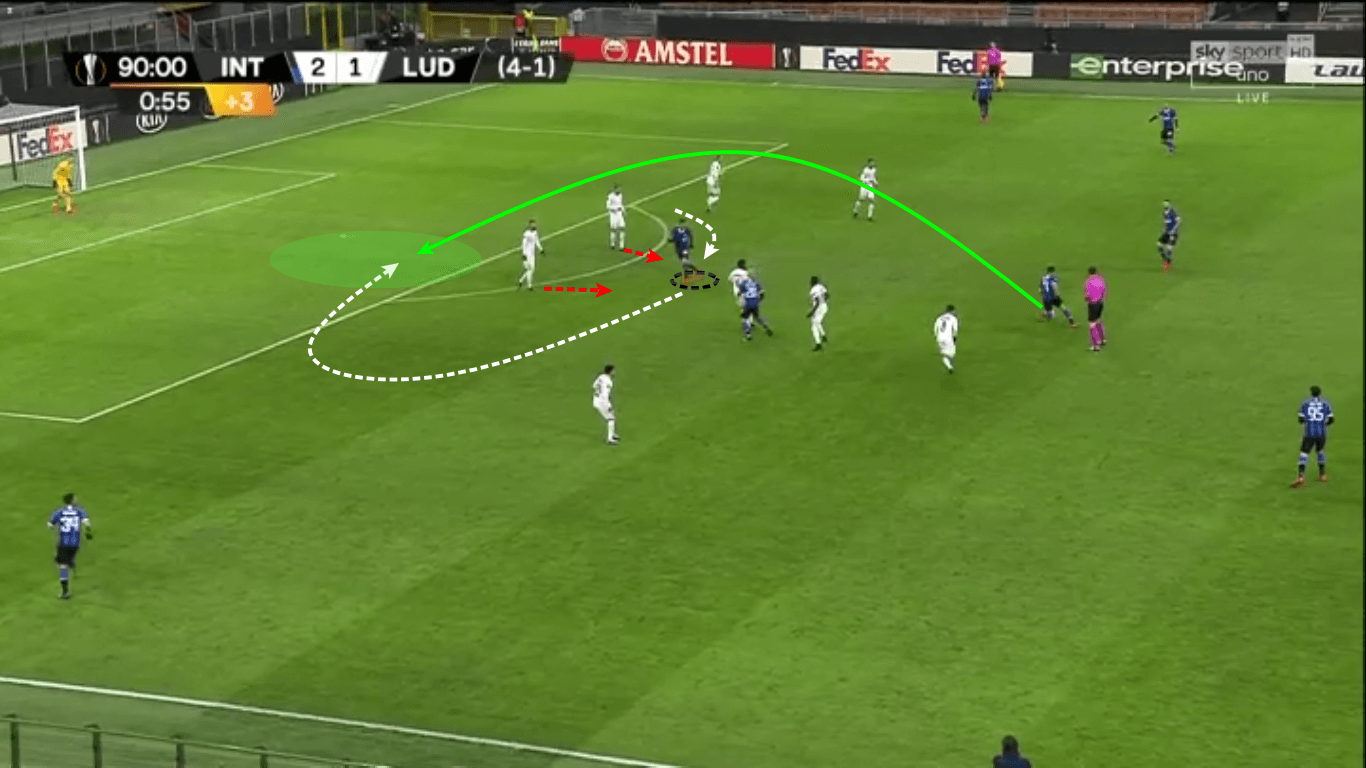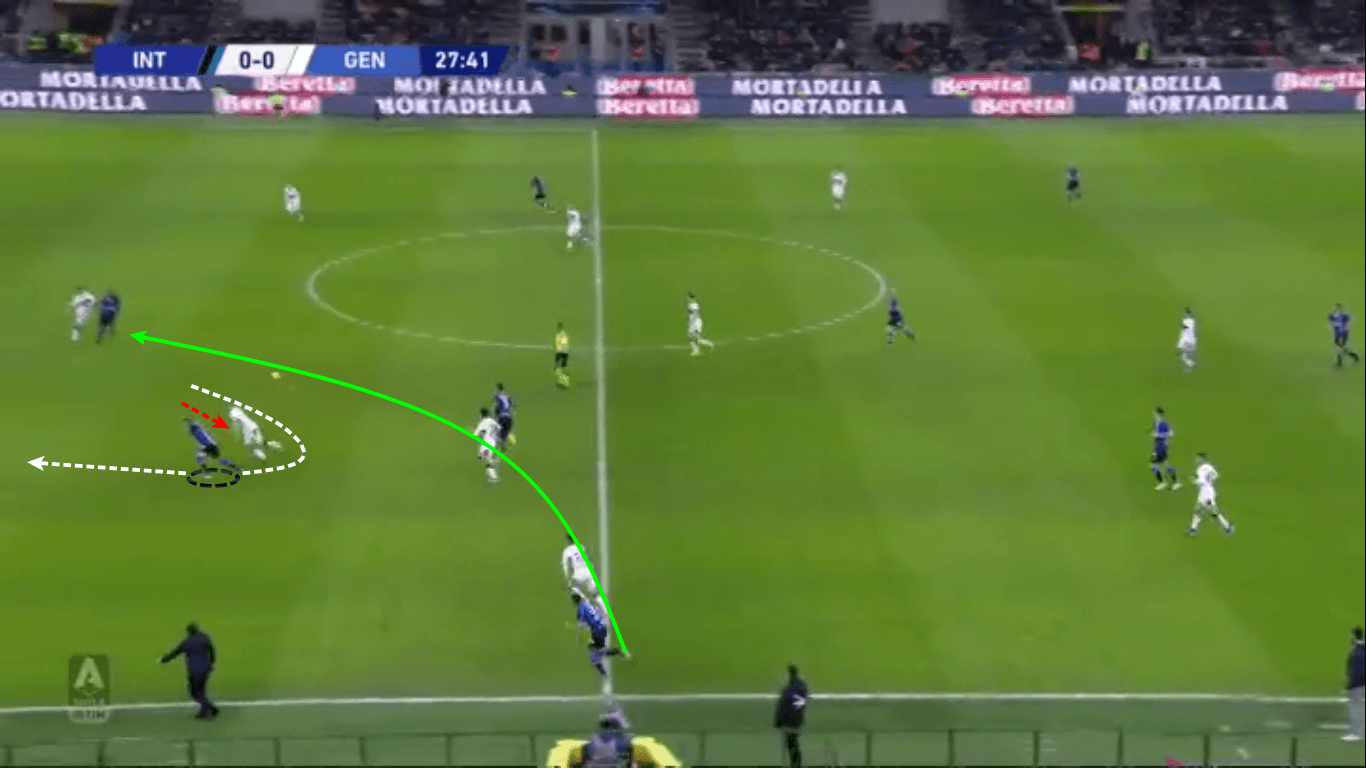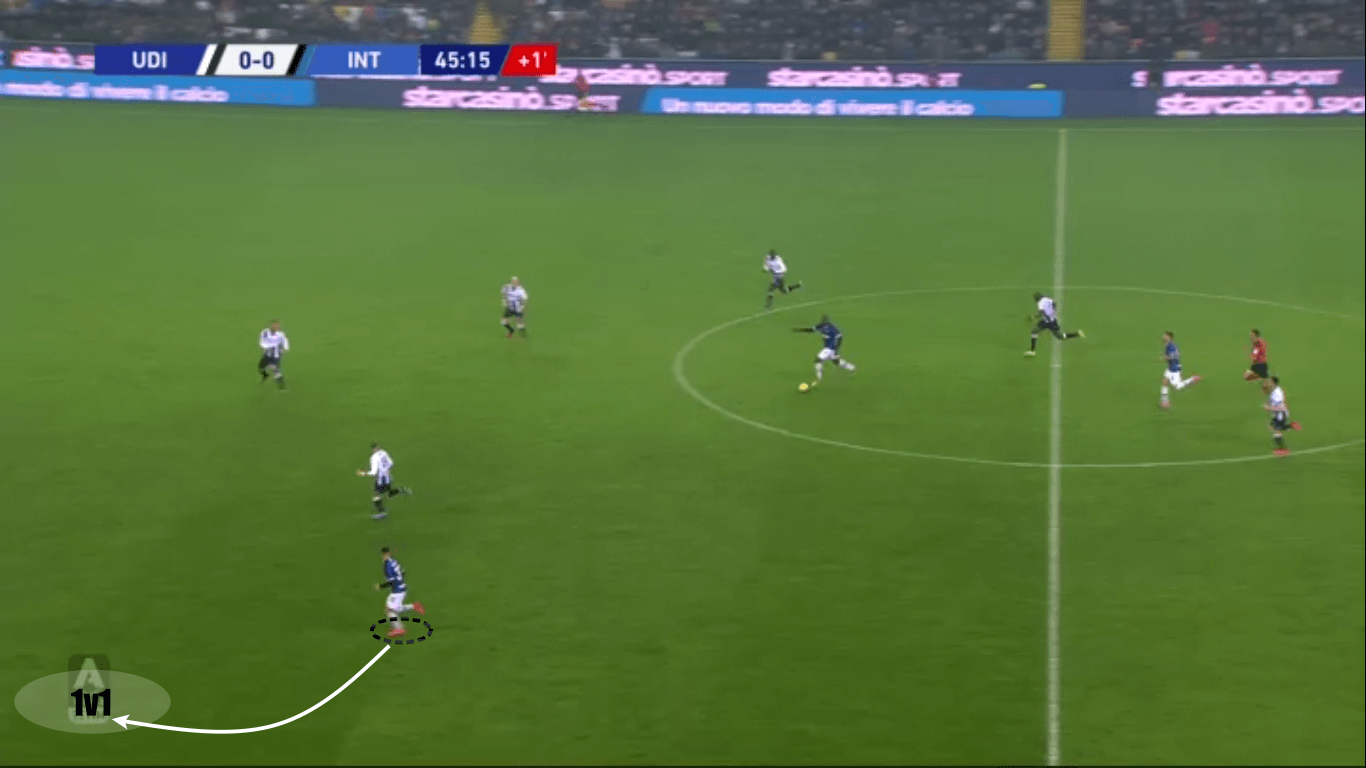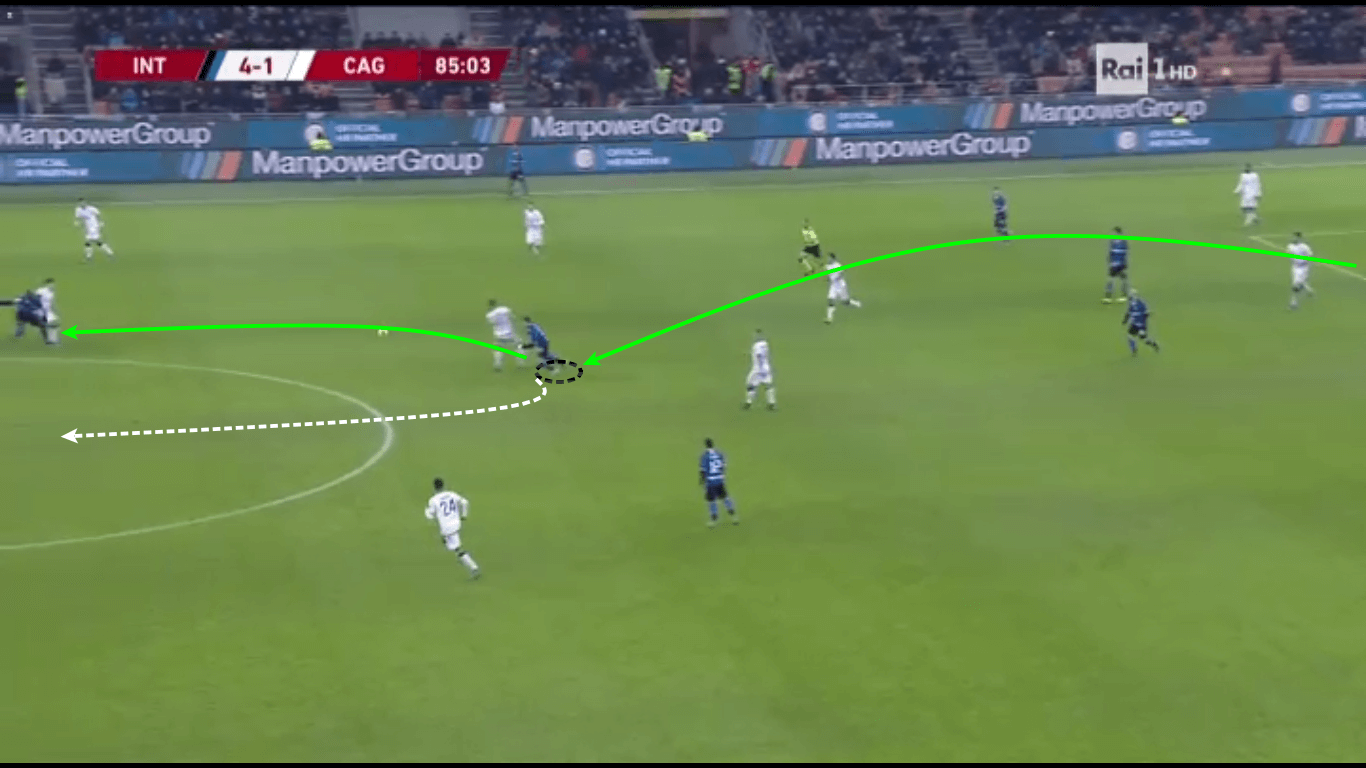In the season which can easily be seen as Inter Milan’s comeback one, due to good results and the clear tactical switch they had under Antonio Conte, they’ve made a huge leap and went back to Europe’s ‘first-tier’ when it comes to speaking about the best teams out there. Even though they didn’t succeed in going into the knock-out phase of the UEFA Champions League, they have shown huge progress in terms of the gameplan and general attitude of the squad, bringing some brilliant players out to light.
Sebastiano Esposito is surely one of the brightest young players they’ve promoted to the first team in the recent years, and although he isn’t a regular starter he has shown that he is a player with magnificent potential. This tactical analysis scout report will show you what are the key basis on which this 17-year-old can build his career and become one of Italy’s next big stars, but also how he fits Nerrazurri’s tactics.
Offensive movements
Esposito still doesn’t get that many chances to play, but the key to his development is that he uses all the minutes he’s been given, and he did it by far performing on a very high level whenever he stepped on the pitch. The brightest segment in his game is the off the ball movement and sense for space as he performs outstanding runs that are perfectly timed time and again throughout the games.
He mostly tends to position himself centrally and at the edge of the offside line trying to create the biggest possible advantage over the direct markers when waiting for passes. Out of those setups, the youngster goes with in-deep run-ins that are directed towards the free area behind the defender’s back and are usually coming from the defender’s blind spot.

Esposito times those motions really good and orients his runs inside-out very frequently, expecting the other striker to come forward centrally and provide support and be included in action-finishing. He repeats deep run-ins time and again keeping pattern the same – waiting for the last moment and doing them from the position where defender can’t take a glance of him.
The 17-year-old has developed great communication with his attacking companions and knows how to utilize their movements. He uses even space when it breaks free after his teammate drops lower and pulls the defenders out of position.

Here we can see an example of that action. Esposito once again goes with a perfectly timed in-deep run whilst Romelu Lukaku comes closer to the player with the ball opening the through-the-air passing lane for his partner.
One of the most interesting things about the young Italian’s game is his maturity in motion, as he oftentimes looks like a player with a lot greater experience than he actually has. He senses the free room with great flair and positions himself in the best possible spots at the right moments so he could get to endanger the goal or create an opportunity for his teammates.

In the picture above, Esposito exploits the gap at the edge of the box that was created with Lukaku’s inside run. He finds himself in the perfect position to get the ball in the dangerous area since he decided not to fill up the box but to calm himself and to wait for the pass. That’s the motion that more experienced strikers repeat more often, but he has a great sense for the action and quite times knows where to position so he could be in a goal-scoring position, even though it doesn’t look there is space for one.
Same happens when the youngster enters the box. He is familiar in performing quick fake motions which confuse defenders who are guarding him and create a lot of space for him to exploit. He often goes with a fake step towards one side, and then continues his run to the other, unmarking himself from the direct guard and making room in which he can get the ball.

Esposito changes his patterns, but the one shown above is a brilliant example of his ‘striker sense’. He uses those, and similar ones, to unmark himself from the opposition creating an unexpected gap in the box which makes it easy for the player on the assist side of the pass to find him as he is unguarded.
Some of those extraordinary motions are really stunning as he repeats runs that are quite rarely seen and so unexpected for the opposing team’s players.

Here we can see Esposito’s magnificent idea to pull out defenders with his slow-low movement. After opposition has gone for the bait, the striker paces up his run and goes behind them in a circular motion, which brings him into a great goal-scoring situation after he gets the in-deep pass from his teammate.
Similar circular motions, with the fake part, take places in all the zones of the pitch and are very helpful in transitive attacks. Esposito likes to pull himself to the flanks starting his runs from the inner-corridors, and his great vision allows him to enable progress for his side and be in support to the other striker, or the player that has the ball at the moment.

When the passes from the flank are addressed towards one of the two attackers, Esposito evaluates the situation and sees if he’s in a better position to get the ball or is his partner, and then he makes a decision. In the situation above, he sensed that Lukaku is a better choice so he made his run as he will receive the ball but faked it, which helped him get to move forward unmarked since the defender got stranded, and Esposito was free to get the through ball from the other striker.
In transitions, the young Italian is commonly used as the threat from the wide position as he is also good in 1v1 setups due to his good technique and dribbling skills. He repeats inside-out runs, in huge pace and provides his team with a flank option in fast transformations.

When he gets the ball close to the sideline, he tends to move inside dribbling quickly the direct guard and trying to go for the pass towards the in-box players or to finish the action by himself if he creates a good-enough situation for a shot.
Link-up play and forward-thinking
Esposito operates better when he has company up top because his motions are of a bigger use when there is another player who can exploit the space the youngster empties or can do the same for him so he can utilize on those rooms, as it is mentioned earlier in the analysis. Even though he’s quite comfortable with a ‘second striker who does the run-ins’ role, he knows when to drop lower and help his teammates with the link-up part of the game.
His inclusion in pass-game of his team is visible both in transitional attacks and in positional ones, and the best he brings lays down in his incredible vision and quickness in motion. In most of the situations, he makes it possible for his team to progress out of the setups that didn’t see forward pass as an option, but due to his good body orientation and sense for the game, he manages to supply teammates in higher zones.

This is especially useful in transitions since he enables quick forward play with just one pass. In the picture above we can see the example of his inclusion in the transitive attacks – he’s addressed with a tough long ball from the goalkeeper, with a player on his back while dropping very low on the pitch. Esposito manages to orient his body in the shape that allows him to play a one-touch pass towards Lukaku, after which he continues his run and opens up once again to become an option, leaving the direct guard behind himself.
In the higher zones, he tends to find a free room in the gaps between the lines, keeping the ‘forward-thinking’ pattern the same. That can be of huge help when his team plays a possessional game, because of his great in-between positioning which makes it possible for them to break one or two of opposition’s defensive lines.

Once again, his main option is to pass the ball to the other striker or to the teammate in the high zone. Also, he drags the defender with himself, usually pulling him out of his position which opens up space for some of Inter’s players to run-in, if he is in position to do so.
The mentioned vision is one of his biggest strengths, and the fact that he doesn’t need to be included in the action directly – he loves to just fake motions in order to create a better position for his side – creates a great advantage for Antonio Conte’s tactics.

Here we can see how his feeling for the game directly helped his team progress faster down the left-hand side. He jumped over the ball, faking that he’ll receive it and confusing the direct guard, leaving the pass go to the second striker who can pass the ball further towards the flank player. Esposito repeats those and similar actions frequently, expelling the defenders out of the game even without contact with the ball. His unselfishness helps his side and opens up a lot of great passing lanes and progressive situations for them.
Defence – pressing and support
Sebastiano Esposito’s youth is best visible in his defensive actions. Like most of the young players, he is very aggressive and goes in full steam to win every single ball, with occasional flaws in the defensive game. Although he sometimes rushes to hard, with no good timing for stopping so he just passes by the player with the ball and leaves the open space, those situations are happening more and more rarely as he matures.
Besides the flaws, he commonly has a great attitude in defence and knows how to call the player with the ball to enter into the pressing traps of his team, which is probably his best segment of defensive game. His body-orientation and mixture of pace in motion are the two key things on which he relies the most when repeating those actions, that are mostly aimed towards the centre-backs.

As we can see, he goes with a circular movement in order to cut down the passing lane towards the other central defender which forces the man with the ball enter the higher zone, in which Esposito’s press intensifies and where he oftentimes wins the ball back. This situation is preceded by his fast run towards the position in the picture from the more central corridor of the pitch, after which he slows down for a second, and then once again goes fully committed to getting the ball in 1v1 duel.
Young Italian also uses his shadow to close down the forwarding options in the middle when one of the centre-backs has the possession. He commonly continues to orient his body in a way that sends the message to the player with the ball that he can’t pass the horizontal ball to the other central defender, whilst guarding the potential pass to the midfielder with his body-shadow and good positioning.

Esposito’s pressure is surely directed with Inter’s tactics, but he does a great job of fulfilling the tasks he’s been given. Since his team mostly tries to call the central defenders to come higher with the ball in their feet, or to counter-press opposition on the flanks, the 17-year-old can be of great help because he’s very comfortable with carrying out those duties and being the first line of team’s defence.

As we mentioned, Esposito is familiar with helping his teammates try to win the ball in counter-pressing next to the sidelines, where he provides support which makes it possible for them to have a numerical advantage over the player with the ball. He also transforms really fast from those setups, opening himself up to become a progress option, so he is a perfect fit for Inter Milan’s direct game.
Conclusion
Sebastiano Esposito is one of the up and coming players of Italian football, and he will surely be a great add-on for the Inter’s tactics in the years to come. If he continues his development in the way he does throughout this season, he will easily become an important first-teamer due to his magnificent abilities, especially the ones related to his final third play and off the ball motions.
As we have shown in this tactical analysis scout report, the young Italian has some flaws in his defensive game, but he works on getting better in that segment of the game, and it is clear that he’s a perfect fit for Conte’s philosophy. One is for certain, he has a huge „ceiling“ and could be one of Italy’s next attacking stars.





Comments